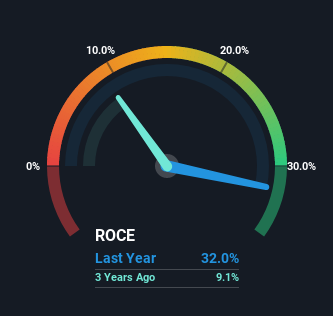Under The Bonnet, IDT's (NYSE:IDT) Returns Look Impressive
What are the early trends we should look for to identify a stock that could multiply in value over the long term? Ideally, a business will show two trends; firstly a growing return on capital employed (ROCE) and secondly, an increasing amount of capital employed. This shows us that it's a compounding machine, able to continually reinvest its earnings back into the business and generate higher returns. Speaking of which, we noticed some great changes in IDT's (NYSE:IDT) returns on capital, so let's have a look.
Return On Capital Employed (ROCE): What Is It?
If you haven't worked with ROCE before, it measures the 'return' (pre-tax profit) a company generates from capital employed in its business. To calculate this metric for IDT, this is the formula:
Return on Capital Employed = Earnings Before Interest and Tax (EBIT) ÷ (Total Assets - Current Liabilities)
0.32 = US$69m ÷ (US$518m - US$302m) (Based on the trailing twelve months to April 2023).
Thus, IDT has an ROCE of 32%. That's a fantastic return and not only that, it outpaces the average of 6.8% earned by companies in a similar industry.
View our latest analysis for IDT
Historical performance is a great place to start when researching a stock so above you can see the gauge for IDT's ROCE against it's prior returns. If you want to delve into the historical earnings, revenue and cash flow of IDT, check out these free graphs here.
What Does the ROCE Trend For IDT Tell Us?
We like the trends that we're seeing from IDT. The data shows that returns on capital have increased substantially over the last five years to 32%. The amount of capital employed has increased too, by 663%. So we're very much inspired by what we're seeing at IDT thanks to its ability to profitably reinvest capital.
In another part of our analysis, we noticed that the company's ratio of current liabilities to total assets decreased to 58%, which broadly means the business is relying less on its suppliers or short-term creditors to fund its operations. This tells us that IDT has grown its returns without a reliance on increasing their current liabilities, which we're very happy with. However, current liabilities are still at a pretty high level, so just be aware that this can bring with it some risks.
In Conclusion...
A company that is growing its returns on capital and can consistently reinvest in itself is a highly sought after trait, and that's what IDT has. And with the stock having performed exceptionally well over the last five years, these patterns are being accounted for by investors. So given the stock has proven it has promising trends, it's worth researching the company further to see if these trends are likely to persist.
If you want to know some of the risks facing IDT we've found 2 warning signs (1 makes us a bit uncomfortable!) that you should be aware of before investing here.
If you'd like to see other companies earning high returns, check out our free list of companies earning high returns with solid balance sheets here.
Have feedback on this article? Concerned about the content? Get in touch with us directly. Alternatively, email editorial-team (at) simplywallst.com.
This article by Simply Wall St is general in nature. We provide commentary based on historical data and analyst forecasts only using an unbiased methodology and our articles are not intended to be financial advice. It does not constitute a recommendation to buy or sell any stock, and does not take account of your objectives, or your financial situation. We aim to bring you long-term focused analysis driven by fundamental data. Note that our analysis may not factor in the latest price-sensitive company announcements or qualitative material. Simply Wall St has no position in any stocks mentioned.
Join A Paid User Research Session
You’ll receive a US$30 Amazon Gift card for 1 hour of your time while helping us build better investing tools for the individual investors like yourself. Sign up here

